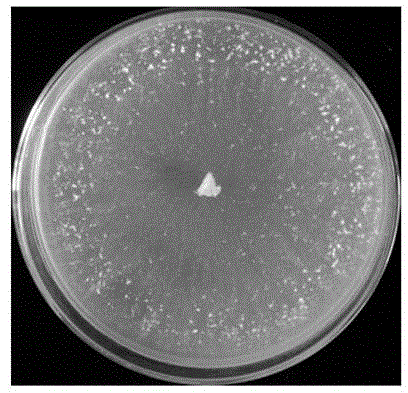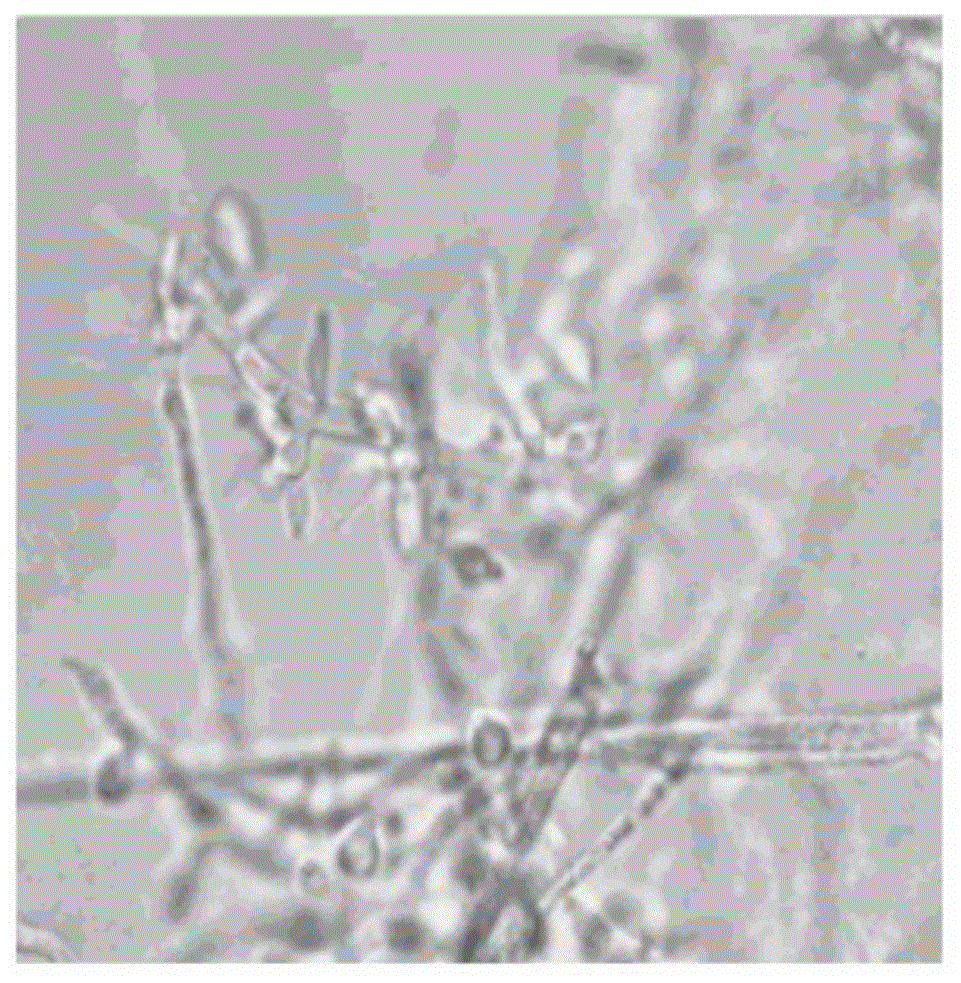Cellulose degradation fungus in intestinal tract of dragonfly larva and application thereof
A cellulose and cellulase technology, applied in the biological field, can solve problems such as research on the activity of cellulase production
- Summary
- Abstract
- Description
- Claims
- Application Information
AI Technical Summary
Problems solved by technology
Method used
Image
Examples
Embodiment 1
[0024] Example 1. Separation and screening of strains
[0025] The yellow dragon larvae were collected from the river near the campus of Zhejiang Normal University. The healthy yellow dragon larvae were surface-disinfected with 75% (vol%) alcohol for 2 minutes, rinsed with sterile water 3 times, the intestines obtained after dissection were placed in a sterile mortar for grinding, and the grinding solution was gradually diluted with sterile water. 10 -1 , 10 -2 , 10 -3 , Respectively take 0.2mL of each gradient dilution and spread it on MEA medium (recipe: 20g malt, 20g sucrose, 20g agar, 1g peptone, distilled water to 1L, pH7.0) plates, and cultivate in a 28°C thermostat. After the colony grows, pick a small amount of hyphae from the edge of the colony and transfer it to the MEA medium plate again to obtain a pure culture of the strain, named QTYC-44, and save it in the preservation medium (the formula is: 20 g of malt, 20 g of sucrose, 20 g of agar, 1 g of peptone, 1 L of dist...
Embodiment 2
[0026] Example 2. Identification of fungus QTYC-44
[0027] 1. Morphological identification
[0028] The preliminary morphological identification of the strains is based on the "Handbook of Identification of Imperfect Fungi". Such as figure 1 As shown, the colony grows faster on MA (wort agar) medium, and the colony diameter is 60-65mm in the dark condition at 28°C for 3 days, and clusters of white conidia can be seen near the edge of the colony. The conidia clusters are densely arranged, do not produce diffuse pigments, and have no obvious odor. Conidiophores directly produce phial stems or secondary branches, and secondary branches tend to be opposite. The conidia are oval, light green, and have smooth walls. The strain can grow in a test tube with Xinhua filter paper as the sole carbon source, and the filter paper will disintegrate significantly within 5 days, indicating that it has high biomass degradation activity.
[0029] 2. Molecular biology identification of strains
[0...
Embodiment 3
[0035] Example 3. Determination of cellulase activity (CMC enzyme activity)
[0036] Inoculate 6 pieces of Trichoderma sp.QTYC-44 cake (diameter 6mm) in 250ml fermentation medium (recipe: 20g malt, 20g sucrose, 1g peptone, 1L distilled water, pH7.0, sterilized at 120°C for 20min) , 28 ℃, pH 7.0 conditions, fermentation for 6 days, take a small amount of fermentation broth to determine the cellulase activity of the fermentation broth. The fermentation broth was centrifuged at 4500 r / min for 20 min, and the supernatant was used as the crude enzyme solution. Take 4 test tubes, 1 tube as a blank control, 3 tubes as parallel sample tubes, add 1 mL of crude enzyme solution to each sample tube, preheat it in a 50℃ water bath for 2 minutes, and then add 4 mL of preheated water to the 3 test tubes. Substrate solution preheated to 50°C (the preparation method of substrate solution is: accurately weigh 0.625g sodium carboxymethylcellulose and dissolve it in 100mL sodium acetate buffer solu...
PUM
| Property | Measurement | Unit |
|---|---|---|
| diameter | aaaaa | aaaaa |
Abstract
Description
Claims
Application Information
 Login to View More
Login to View More - R&D
- Intellectual Property
- Life Sciences
- Materials
- Tech Scout
- Unparalleled Data Quality
- Higher Quality Content
- 60% Fewer Hallucinations
Browse by: Latest US Patents, China's latest patents, Technical Efficacy Thesaurus, Application Domain, Technology Topic, Popular Technical Reports.
© 2025 PatSnap. All rights reserved.Legal|Privacy policy|Modern Slavery Act Transparency Statement|Sitemap|About US| Contact US: help@patsnap.com



